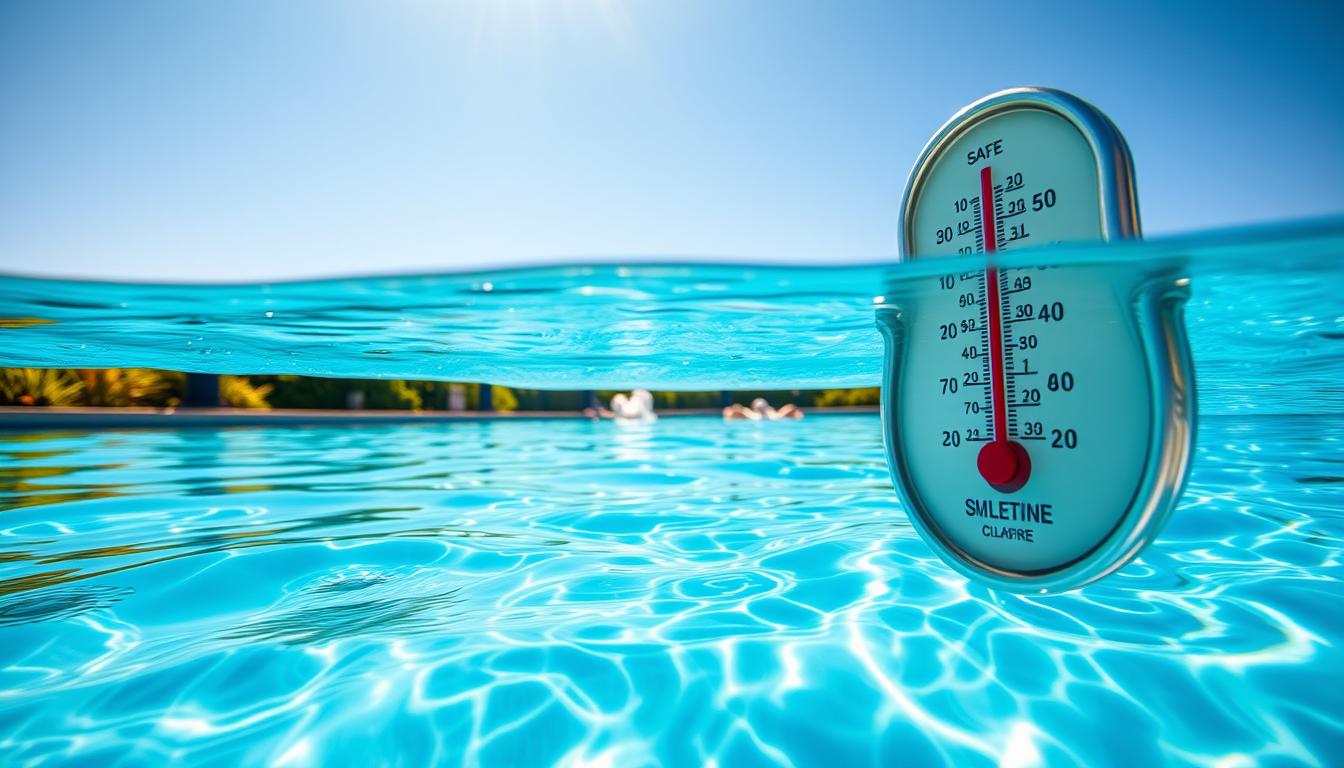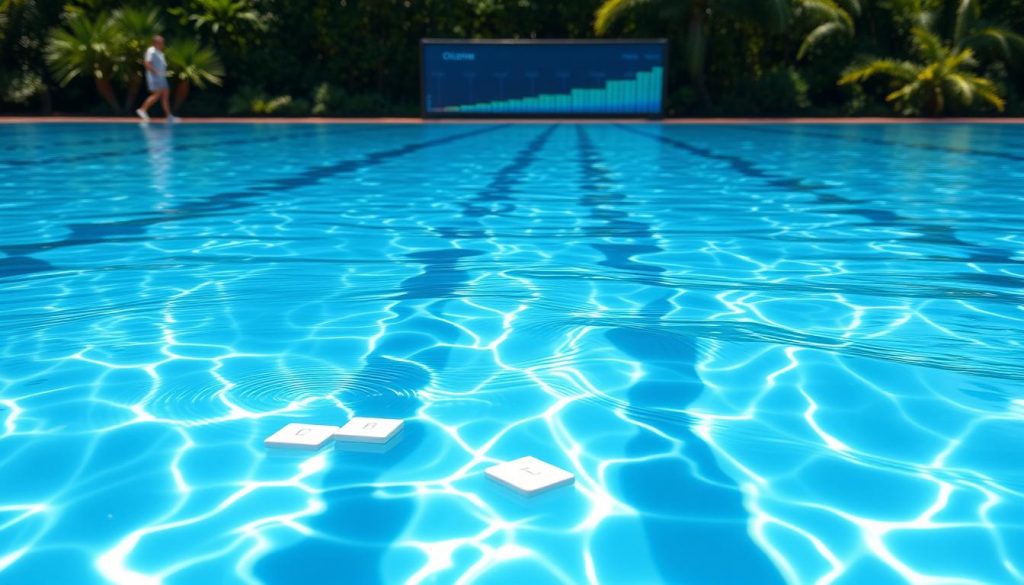
It’s a hot summer day, and you’re ready to jump in your pool. But you just added chlorine. You don’t want to expose anyone to harmful chemicals. So, when is it safe to swim?
Pool owners know that keeping proper chlorine levels in the swimming pool is vital. It keeps the water clean and germ-free. But finding the right balance between sanitation and safety can be challenging.
This guide will help you understand waiting periods after chlorinating pools. We’ll also cover safe chlorine levels for swimming. Our tips will ensure your pool stays safe all summer long.
Understanding swimming after shocking your pool is crucial for all pool owners. Our recommendations will help you create a safe swimming environment for everyone.
Understanding the Basics of Pool Chlorination
Chlorine is crucial for keeping pool water safe and clean. It helps create a healthy swimming environment. Proper guidelines for pool chemical safety are essential for everyone’s well-being.
Monitoring chlorine levels and dissipation rates is important. This ensures safe swimming conditions. Following these practices minimizes risks from pool chemical exposure.
The Role of Chlorine in Pool Sanitation
Chlorine is the top choice for pool sanitization in South Africa. It forms hypochlorous acid in water, killing bacteria, viruses, and algae. Balancing chlorine levels prevents irritation while ensuring effective sanitation.
Several factors affect how quickly chlorine dissipates in pools. Sunlight can break down chlorine molecules. High water temperatures speed up chlorine loss. More swimmers introduce contaminants that use up chlorine.
Regular testing and adjusting of chlorine levels is vital. The ideal range for pool chlorine is 1 to 3 parts per million (ppm).
Balancing Pool Chemistry for Optimal Safety
Balanced pool chemistry is key for swimmer comfort and safety. It’s important to monitor several water parameters regularly.
| Parameter | Ideal Range | Effect on Chlorine Efficiency |
|---|---|---|
| pH | 7.4 – 7.6 | Low pH increases chlorine effectiveness but may cause irritation; high pH reduces chlorine efficacy |
| Alkalinity | 80 – 120 ppm | Helps stabilize pH and prevent rapid fluctuations |
| Calcium Hardness | 200 – 400 ppm | Prevents corrosion of pool surfaces and equipment |
| Cyanuric Acid | 30 – 50 ppm | Stabilizes chlorine, reducing UV degradation and extending its lifespan in the pool |
Regular testing and adjusting of these parameters optimizes chlorine effectiveness. This practice minimizes risks from pool chemical exposure. Proper maintenance and safety guidelines ensure a fun, safe swimming experience.
Factors Influencing Chlorine Dissipation Rates
Many factors affect how quickly chlorine disappears from swimming pools. These factors impact when it’s safe to swim after adding chlorine. Knowing these factors helps maintain a safe swimming environment.
Type and Strength of Chlorine Used
The type of chlorine used affects how fast it disappears. Chlorine tablets provide a steady supply over time. Liquid and granular chlorine dissolve more quickly.
Stronger chlorine products take longer to dissipate. Shock treatments may require longer waiting times before swimming. This is due to higher chlorine levels in the water.
Pool Size and Water Volume
Pool size and water volume influence chlorine dissipation time. Larger pools need more chlorine to reach the right concentration. This leads to longer dissipation times.
Calculate the right amount of chlorine based on pool size. Follow the manufacturer’s instructions for proper use and safe swimming conditions.

Environmental Factors: Sunlight, Temperature, and pH Levels
Sunlight, temperature, and pH levels affect chlorine dissipation rates. UV rays break down chlorine molecules, reducing their effectiveness. Higher water temperatures speed up chlorine dissipation.
pH levels are crucial for chlorine’s effectiveness. The CDC recommends keeping pool water pH between 7.2 and 7.8. The optimal range is 7.4 to 7.6.
When pH levels rise, chlorine’s sanitizing power decreases. This leads to slower dissipation and potential health risks for swimmers.
| pH Level | Effect on Chlorine Effectiveness |
|---|---|
| Below 7.2 | Chlorine dissipates more quickly, causing eye and skin irritation |
| 7.2 – 7.8 (Recommended) | Optimal range for chlorine effectiveness and swimmer comfort |
| Above 7.8 | Chlorine becomes less effective, leading to slower dissipation rates and potential health risks |
Regular testing and adjustments are needed to maintain proper pH levels. This ensures optimal chlorine performance. Managing these factors creates a safe and enjoyable swimming experience.
Recommended Wait Times for Safe Swimming
Understanding safe swimming times after adding pool chemicals is vital. These guidelines maintain proper pool chemistry and prevent health risks. They ensure a safe and enjoyable swimming experience for everyone.
Regular Chlorine Maintenance: 15-30 Minutes
For routine chlorine maintenance, it’s safe to swim 15-30 minutes after application. This allows chlorine to spread evenly throughout the pool. Always check the product label for specific instructions.
Use a test kit to confirm chlorine levels are between 1-3 ppm before swimming. This ensures the water is safe for swimmers.
Shocking the Pool: Up to 24 Hours
Pool shock treatment adds a high dose of chlorine to eliminate contaminants. After shocking, wait up to 24 hours before swimming. This allows chlorine levels to stabilize.
Swimming is unsafe if chlorine levels exceed 4 ppm. Wait about one hour per pound of shock product added. Always test the water before swimming.
According to pool maintenance experts, potential consequences of swimming too soon after shocking a pool include skin and eye irritation, discoloration of clothing and swimwear, and even illness from ingesting chlorinated water. In severe cases, exposure to high levels of chlorine can exacerbate skin conditions and lead to symptoms like difficulty breathing, vision loss, and burns.
Algaecide Treatments: Minimum 24 Hours
Algaecide treatments prevent and control algae growth in pools. After applying, wait at least 24 hours before swimming. This allows the product to work effectively.
Keep the pool pump running to distribute the algaecide evenly. Follow the manufacturer’s instructions and test the water before use.
| Treatment | Recommended Wait Time | Key Considerations |
|---|---|---|
| Regular Chlorine Maintenance | 15-30 minutes | Ensure chlorine levels are between 1-3 ppm before swimming |
| Pool Shock Treatment | Up to 24 hours | Wait until chlorine levels drop below 4 ppm; test water before swimming |
| Algaecide Treatment | Minimum 24 hours | Keep pool pump running; follow manufacturer’s instructions; test water before swimming |
Follow these wait times after adding chemicals to your pool. Test your pool water regularly to maintain proper chemistry. This ensures crystal-clear water and a safe swimming environment all season long.
How Long After Chlorine Can You Swim: Expert Guidelines
Safe swimming requires proper pool maintenance and chlorine guidelines. Wait at least one hour after adding regular chlorine before swimming. This allows chlorine to spread evenly, reaching 1-3 parts per million (ppm).
After shocking your pool with high chlorine, wait up to 24 hours. This ensures chlorine levels drop below 5 ppm, preventing irritation. Avoid swimming while chlorine tablets dissolve to prevent high concentrations.
When using cyanuric acid (CYA) granules, wait 2-3 days before swimming. Place granules in a sock and hang it near a return. Run the pump for 48 hours to dissolve them.
Wait 3 days after dissolving granules before testing CYA levels. This ensures accurate readings and proper pool chemistry. Regular testing helps maintain a safe, clean swimming environment for everyone.







